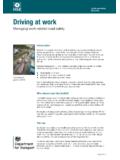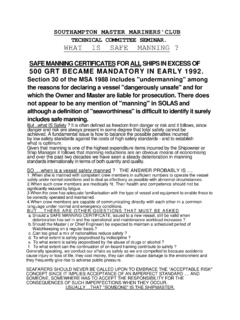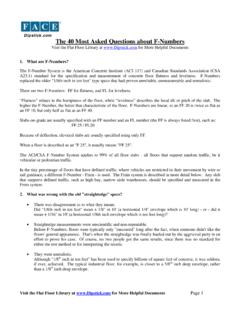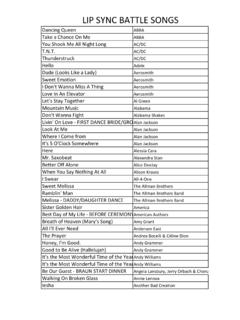Transcription of AIRCRAFT OIL USAGE - T-Craft Aero Club
1 AIRCRAFT OIL USAGEJIM EYREMost oil knowledge is something that someone told someone who heard it from somebody . But, as they say on X-Files, The truth is out there. Almost all general aviation piston engines have a wet sump, a built-in oil reservoir, instead of an external oil tank. How can you determine by looking at the oil dipstick of a wet-sump engine the minimum oil quantity with which the engine can be operated safely? It is one-half of the maximum indication etched on the dipstick. If the engine holds 12 quarts, for example, it can be operated with a minimum of six.
2 (Refer to Federal Aviation Regulation ). Low-time pilots who sidle up to longtime fliers are often surprised when the graybeards scoff at their practice of completely filling their airplane s oil reservoir. It s going to blow out all over the belly if you fill it up, the old-timers say. They re correct. Here s the lowdown on engine oil capacities. Way back in the early days of aviation, the rule makers had gathered their experience from the radial engine Transport Category airplane world. So they worded the regulation related to engine oil capacity to read, The usable oil tank capacity shall not be less than the product of the endurance of the airplane under critical operating conditions and the maximum oil consumption of the engine under the same conditions, plus a suitable margin to assure adequate system circulation and cooling.
3 The oil capacity of an engine is predicated on the endurance of the airplane! What does this mean to us ordinary pilots? When an engine is being designed the company wants its new offering to be favorably looked on by as many airframe manufacturers as possible for as many of their airplanes as possible. Following the mandates governing tank capacity, it follows that the engine manufacturers did not want the oil capacity of their engines to limit their market, so they built in extra capacity. Civil Aeronautics Administration Manual No. 107 (January 1949), titled AIRCRAFT Power Plant Handbook, adds oil-tank capacity guidelines when it says, The customary ratio is one gallon of oil for every 25 gallons of fuel, but not less than one gallon for every 75 maximum continuous horsepower of the engine involved for non-Transport category airplanes.
4 Is it any wonder that engines have overly large oil capacities? T-Craft Cessna 182s have a 230-horsepower O-470(R, L, U) engine. The oil capacity of this engine is 12 quarts, yet it is quite safe to fly a four-hour flight with only 8 or 9 quarts in the sump. Experience has shown that oil added above the nine-quart level is quickly blown out the crankcase breather tube, which exits the engine compartment at the right cowl flap. This blowing out results in a very oily belly (those members that clean the belly s at plane wash can attest to this).
5 Safety is not enhanced when the sump is full of oil. However it is expensive The newest regulations governing the standards of AIRCRAFT engines are found in Part 33 of the FARs, particularly Part which says that oil systems must be designed and constructed to ensure proper operation in all flight attitudes and conditions. For airplanes with wet sump systems ( T-Craft fleet) this requirement must be met when only one-half of the maximum lubricant supply is in the engine. How much is not enough? John Frank, at Cessna Pilot Association, says, There are two oil levels enough and not enough.
6 The not-enough level will be signaled by a rise in oil temperature and a decrease in oil pressure as long as the temperature is stable you have enough oil. So for regulatory reasons airplane engine sumps are generous in relation to the needs of the engine, and somewhere between very full and half-full is the sweet spot identifiable by stable oil temperatures and stable oil consumption. The best time to get an accurate dipstick reading is just prior to the first flight of the day. If you check the oil level shortly after the engine has been run for a while, the dipstick reading will be noticeably lower because a significant quantity of oil remains adhered to various engine components.
7 Another reading taken 24 hours later will often show an oil level that is 1 2 to 1 quart higher. Oil consumption is a very important trend to monitor in an engine; therefore we try and keep track of how many quarts of make-up oil are added between oil changes by having T-Craft Members record on the sign-out sheet if they add any oil. Usually we find that less oil is consumed soon after oil change and more added as time progresses (oil s time in service increases). Experience has shown us that 4-6 quarts for the 152, 6-8 quarts for the 172s and 8-10 quarts for the 182s is quite sufficient.
8 If you feel you need to top it off according to dipstick markings than please show at next plane wash and volunteer to clean the under carriages. The following contributed to this article: Cessna Pilot Association; AOPA Pilot; Aviation Maintenance Bulletin; Sport Flying Magazine; Textron Lycoming Flyer Newsletter, and our faithful local mechanics. CHECKING THE DIPSTICKNOVEMBER 15, 2016 / MIKE BUSCH / 10 COMMENTS There s a lot more to checking the dipstick than just noting the oil level. The appearance of the oil is at least as important as its ve been doing it since our earliest days as student pilots.
9 Now that we re AIRCRAFT owners, we still do it as part of our standard preflight ritual. But are we doing it right?It turns out that there s a lot more to checking the engine s oil dipstick properly than just making sure that the oil level is above the minimum-for-flight level listed in the POH. If we really pay attention, we can learn a lot about the condition of our oil and of our MUCH OIL IS NEEDED?The engines on my Cessna 310 have 12-quart sumps 13 quarts if you include the quart in the spin-on oil filter. When I first acquired the airplane, my mechanic would fill the sump to its maximum capacity at each oil change.
10 It didn t take me long to discover that the engines didn t like that, and promptly tossed several quarts out the engine POH states that the minimum for flight oil level is 9 quarts. So I asked my mechanic to service the sump to 10 quarts (instead of 12), and I d add a quart of make-up oil when the level got down to 9 quarts. That worked better, but I was still seeing a fair amount of oil on the underside of the engine nacelles and the outer gear I became a mechanic myself and learned about such things, I checked the Type Certificate Data Sheet (TCDS) for my Continental TSIO-520-BB engines, and found that an oil level of 6 quarts was sufficient to make good oil pressure in all flight attitudes from 23 nose-up to 17 nose-down.




